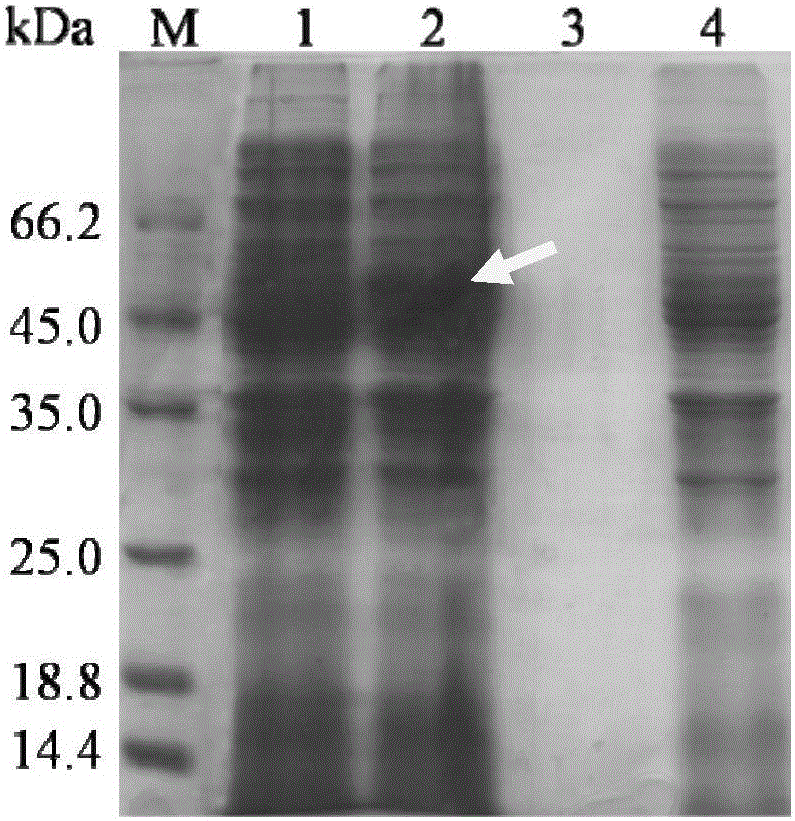Method for improving flour processing quality by applying recombined wheat endoplasmic reticulum sulfydryl oxidordeuctase
A technology of reticulothiol and reductase, applied in the fields of genetic engineering and grain science, can solve the problems of complex additive components and cost, restrict the practical application of wEro1, explore the influence of wEro1, etc., and achieve easy amplification, lower production costs, and simple purification. Effect
- Summary
- Abstract
- Description
- Claims
- Application Information
AI Technical Summary
Problems solved by technology
Method used
Image
Examples
Embodiment 1
[0037] Example 1 Recombinant wheat endoplasmic reticulum sulfhydryl oxidoreductase expression vector construction
[0038]The wheat endoplasmic reticulum sulfhydryl oxidoreductase gene (SEQ ID NO: 1) was synthesized in Guangzhou Aiji Biotechnology Co., Ltd., and connected to the cloning vector pGSI. Take 1 ng of the recombinant cloned plasmid, react with NdeI and XhoI restriction endonucleases (37°C, 30min), perform agarose gel electrophoresis and purify the wheat endoplasmic reticulum sulfhydryl oxidoreductase gene fragment with sticky ends. 20 μg of the gene fragment was mixed with 5 μg of the plasmid pET-28a(+) digested with the same restriction enzyme, and ligated under the action of T4 DNA ligase at 20° C. for 1 h. After ligation, the product was transformed into Escherichia coli DH5α competent, spread on LB solid medium containing kanamycin and cultured for 12-16 hours. The plasmids were extracted from monoclonal colonies with full shape, and the recombinant plasmids we...
Embodiment 2
[0040] Example 2 Induced expression and purification of recombinant wEro1
[0041] 1. Induced expression of recombinant wEro1
[0042] Transform the constructed recombinant plasmid pET-28a-wero1 into BL21(DE3), pick 3 monoclonal colonies and put them in LB medium containing 50 μg / mL kanamycin, culture at 37°C and 200r / m to OD 600 To about 0.6-0.8, add 0.2-1mM IPTG to induce expression for 8-12 hours, and the induction temperature range is between 16-37°C. Through SDS-PAGE analysis, the recombinant wEro1 obtained soluble expression ( figure 2 ).
[0043] 2. Affinity purification of recombinant wEro1
[0044] The expressed bacteria were collected, resuspended by adding buffer, and the cells of the bacteria were disrupted by a probe-type ultrasonic instrument. The ultrasonic condition was 350w, the duty ratio was 0.4:0.6, and the ultrasonic was 15min. After the sonication was complete, the supernatant was collected after centrifugation at 8000r / m for 20min.
[0045] The su...
Embodiment 3
[0048] The enzymatic properties of embodiment 3 recombinant wEro1
[0049] wEro1 contains a variety of enzymatic properties. In this example, the convenient FAD reducing activity is selected for detection. The principle is that the coenzyme FAD of wEro1 can be reduced to FADH under the action of dithiothreitol (DTT) 2 , the latter has no absorbance at 450nm. Therefore, the FAD reduction activity of wEro1 can be explored by detecting the change of absorbance at 450nm.
[0050] The enzyme activity assay reaction system was as follows: 2 μM wEro1 and 10 μM FAD were added to 50 mM Tris-HCl (pH 8.0) buffer solution, 12.5 mM DTT was added to start the reaction, and the absorbance was measured at 450 nm.
[0051] Result: if Figure 4 As shown, after adding DTT, wEro1 exhibited obvious FAD reducing activity.
PUM
 Login to View More
Login to View More Abstract
Description
Claims
Application Information
 Login to View More
Login to View More - R&D
- Intellectual Property
- Life Sciences
- Materials
- Tech Scout
- Unparalleled Data Quality
- Higher Quality Content
- 60% Fewer Hallucinations
Browse by: Latest US Patents, China's latest patents, Technical Efficacy Thesaurus, Application Domain, Technology Topic, Popular Technical Reports.
© 2025 PatSnap. All rights reserved.Legal|Privacy policy|Modern Slavery Act Transparency Statement|Sitemap|About US| Contact US: help@patsnap.com



